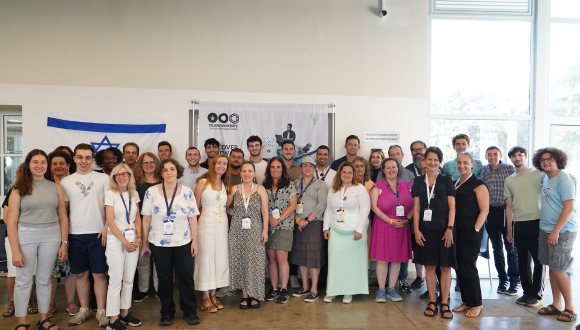Can Smartwatches Prevent Pandemic Outbreaks?
Researchers Discover How Smartwatches Can Stop Disease Spread by Early Detection
Researchers from the Department of Industrial Engineering at TAU’s Faculty of Engineering led a two-year study in which participants wore smartwatches that measured biomarkers and answered questions about their health every day. The results indicate that the wearable technology identified a change in key physiological parameters one to three whole days before the user felt the first symptom of the disease: a gap of 23 hours for COVID-19, 62 hours for group A streptococcus (GAS), and 73 hours for influenza.
The researchers: “Early diagnosis enabled by wearable technologies can be critical for inducing behavioral changes, such as reduced social contacts at an early stage, when the disease is most infectious. Potentially, this can prevent the spread of disease and even preempt global pandemics in the future”.
The study was led by Prof. Dan Yamin, an expert in epidemiology and infectious disease modeling and Head of the Lab for Digital Epidemiology and Health Analytics, and Prof. Erez Shmueli, Head of the Big Data Lab, both from TAU’s Department of Industrial Engineering. Other participants included: research students Shachar Snir and Matan Yechezkel from the Department of Industrial Engineering, Dr. Tal Patalon from the Kahn Sagol Maccabi Research and Innovation Center at Maccabi Healthcare Services and Yupeng Chen and Prof. Margaret Brandeau from the Department of Management Science and Engineering at Stanford University. The paper was published in Lancet Regional Health Europe.
Prof. Yamin: “Infectious diseases and pandemics pose a great threat to humanity, and we must harness our scientific and technological abilities to prevent them. Previous studies have shown that during the recent pandemic about 40% of all transmissions occurred about a day before the first symptoms appeared. In other words, the person transmitting the disease was unaware they were infected. In this study we checked whether wearable technologies could provide earlier diagnosis, to reduce contagion and prevent the spread of infectious diseases”.
Tracking Key Health Changes
During the two-year study, 4,795 Israelis over 18 years of age wore a smartwatch that continuously monitored key physiological parameters, focusing on pulse rate at a 15-second resolution and HRV (Heart Rate Variability). Prof. Yamin explains: “Pulse rate and HRV provide crucial information about the two most important systems in our body – the heart and the brain. Our brain constantly consumes energy, burning oxygen provided by the cardiovascular system, and consequently, any change in our activity or condition is immediately reflected in a change in HRV. When a person becomes ill, most of the focus goes to a single system – the immune system battling the disease, keeping the heart rate relatively steady, and reducing its variability, the HRV. In this way, changes in HRV indicate physical stress”.
In addition to wearing the smartwatches, participants answered a series of general questions about their condition every day: How do you feel physically? How do you feel mentally? Have you engaged in physical activity? Do you have any specific symptoms? Etc. In addition, they were provided with home test kits for three different diseases – COVID-19, influenza, and group A streptococcus – which they used at their discretion. Over two years, the researchers collected 800,000 questionnaires and this data was compared with parallel data from the smartwatch. Altogether, the data included 490 episodes of influenza, 2206 episodes of COVID-19, and 320 episodes of GAS.
Based on their abundant data, the researchers built special models that identified three critical points in time following exposure to an infectious disease. For instance, COVID-19: A. The first physiological anomaly in heart rate measures – 96 hours after exposure, an interval, which the researchers call the ‘digital incubation period’; B. The first symptom noticed by the person –130 hours after exposure, an interval commonly known as the ‘incubation period’; and C. Testing that ultimately diagnosed the disease – usually about 168 hours after exposure, called the ‘diagnostic decision period’. The period from exposure to digital diagnosis, namely the digital incubation period, was even shorter for influenza (24 hours) and GAS (60 hours).
Getting Ahead of the Curve?
Prof. Shmueli: “Early diagnosis is extremely important for preventing the spread of the disease. Moreover, we found that even when our subjects reported first symptoms, they tended to postpone testing for a while – 53 hours for COVID-19, 39 hours for influenza, and 38 hours for GAS. Consequently, for quite a long interval, from exposure to testing, they did not change their social behavior, spreading the disease to others. We found that on average, people performed the test and changed their behavior when the disease was already past its peak, and they were much less likely to infect others. The delay between digital diagnosis and testing – 64 hours in the case of COVID-19, 68 hours for influenza, and 58 hours for GAS – is thus extremely crucial”.

Prof. Yamin: “Our findings indicate that at the population level digital diagnosis can significantly reduce the spread of infectious diseases, by causing people to change their social behavior at a much earlier stage of the disease. This can even prevent the next pandemic – by bringing the basic reproduction number (R0value) to below 1.0, which means that every sick individual transmits the disease to less than one other person, and the disease soon dies out”.
The researchers add that early diagnosis is also critical for effective treatment. Specifically, for COVID-19, existing treatments are very effective only when given early on, preventing severe illness, hospitalization, and even death.
A Milestone in Stopping Pandemics
Prof. Yamin: “In an ERC-funded paper published in October 2019, shortly before the outbreak of the COVID-19 pandemic, I argued that infectious diseases pose the greatest threat of a global catastrophe. The threat is especially great in the modern world, with people traveling all over the globe and potentially spreading new diseases. However, modern technology can help us combat this danger and devise more effective public health strategies. Our new method, using wearable sensors for early detection of contagious disease can potentially reduce the threat of epidemics to a minimum. Smartwatches are a relatively new technology, with enormous potential, and novel, even more sensitive and accurate wearable sensors are constantly being developed. Ultimately, this can be a high-impact tool for preempting future pandemics”.







































